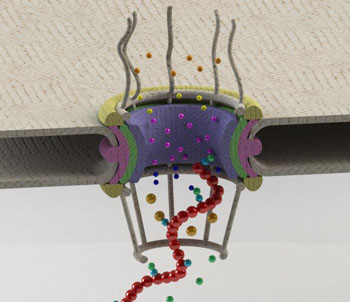Messenger RNA Quality Control Mechanism Explained
By Gerald M. Slutzky, PhD
Posted on 15 Nov 2016
Genomics researchers have described a mechanism that explains how molecules of messenger RNA (mRNA) are checked for accuracy before being released from the nucleus into the cytoplasm.Posted on 15 Nov 2016
Export of mRNAs into the cytoplasm is a fundamental step in gene regulation processes, which undergo quality control by highly efficient mechanisms in eukaryotic cells. However, it remains unclear how the aberrant mRNAs are recognized and retained inside the nucleus.

Image: Schematic of a gateway in the nuclear membrane, known as the nuclear pore complex (NPC), and the proteins (shown as spheres) involved in transport and quality control of mRNAs (shown in red). A combination of a multitude of protein-protein interactions enables the cell to distinguish and keep aberrant mRNAs from exiting the nucleus (Photo courtesy of Mohammad Soheilypour, Berkeley National Laboratory).
To better understand the quality control process, investigators at Berkeley National Laboratory (CA, USA) and the University of California, Berkeley (USA) used a new modeling approach for complex systems, namely the agent-based modeling (ABM) approach, to develop a minimal model of the mRNA quality control (QC) mechanism.
They reported in the November 2, 2016, online edition of the journal Scientific Reports that regulation of the affinity of RNA-binding proteins (RBPs) to export receptors along with the weak interaction between the nuclear basket protein (Mlp1 or Tpr) and RBPs were the minimum requirements to distinguish and retain aberrant mRNAs. The results showed that the affinity between Tpr and RBPs was optimized to maximize the retention of aberrant mRNAs.
The length of the mRNA strand affected the QC process. Since longer mRNAs spent more time in the nuclear basket to form a compact conformation and initiate their export, nuclear basket proteins could more easily capture and retain them inside the nucleus.
"Just like all production lines, the process of genetic information transfer and protein production is quality controlled at different stages," said senior author Mohammad Mofrad, professor of bioengineering and of mechanical engineering at the University of California, Berkeley. "To date, the exact mechanism of this quality control step has remained unclear. Some components of this machinery are dysregulated in various types of cancers. Understanding the molecular mechanism of genetic information transport and quality control would substantially improve the current knowledge about various types of cancers and other human diseases."
Related Links:
Berkeley National Laboratory
University of California, Berkeley














